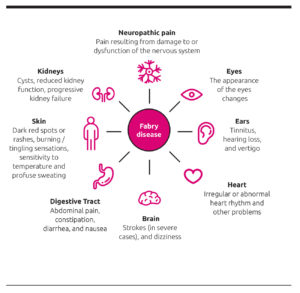Diagnosis of Fabry Disease:
The doctor may suspect Fabry disease if the patient has the associated signs and symptoms. If one of the patient’s relatives is found to have the disease, the physician will order a blood test to measure a-GAL A activity.
Screening females for Fabry disease is less simple. The blood test can be misleading, due to the random nature of X-inactivation. X-inactivation means that the faulty gene may be switched off, so the enzyme a-GAL A won’t be affected.
A chromosomal analysis of the GLA gene is more accurate than a blood test.
If excessive GL-3 buildup is detected, a kidney biopsy may help.
Treatment of Fabry Disease:
Controlling or preventing symptoms and complications is the main aim of treatment.
Episodes of pain are nearly always linked to certain triggers, such as exposure to heat, temperature changes, sun exposure, exercise, and fever. The patient must learn to avoid these pain triggers.
For patients with severe and frequent episodes of pain, the doctor may prescribe an anticonvulsant, such as carbamazepine (Tegretol, Tegretol XR, Equetro, Carbatrol) or diphenylhydantoin (Dilantin). They should be taken daily.
Enzyme replacement therapy (ERT) is a medical treatment that replaces an enzyme which is either absent or deficient in patients. In Fabry disease patients’ cases, the missing enzyme is alpha-galactosidase A (a-GAL A).
In the United States, Fabrazyme is the only ERT treatment approved by the U.S. Food and Drug Administration (FDA) for Fabry disease.
The producers, Genzyme Corporate, write on their website “The lowering of GL-3 suggests that Fabrazyme may improve how Fabry disease affects your body; however a relationship of lower GL-3 to specific signs and symptoms of Fabry disease has not been proven.”
The treatment has passed all clinical trials and its safety and effectiveness have been demonstrated. It is, however, expensive.
The other complications related to Fabry disease, such as skin, heart, kidney, and psychological problems are treated separately as they occur, by specialist doctors. For example, heart symptoms will be treated by a cardiologist.
